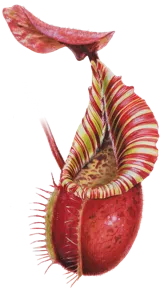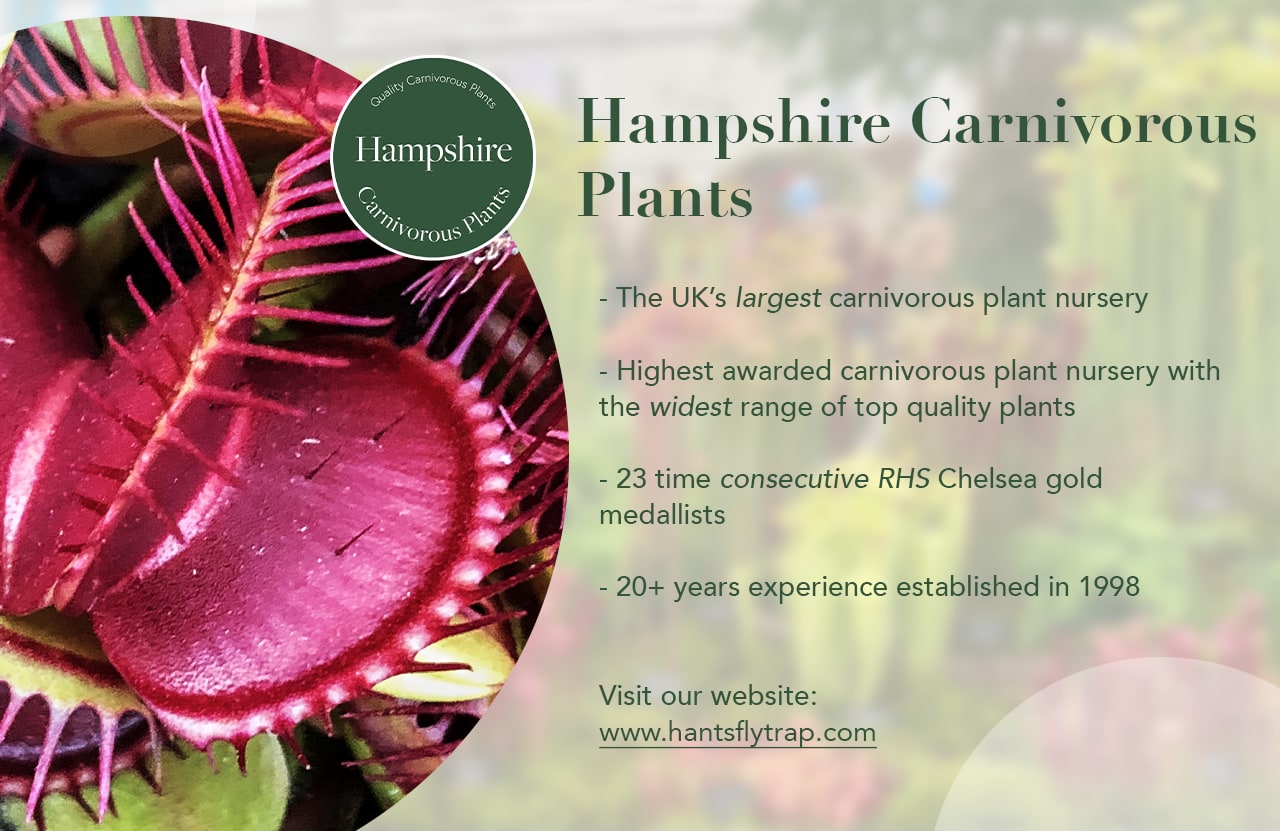As an Amazon Associate, I earn commission from qualifying purchases.
Without a doubt the most famous carnivorous plant, the Venus Flytrap is - for many growers - a gateway drug! Charles Darwin famously described the plant as “one of the most wonderful in the world,” and few who have witnessed a healthy trap snapping shut on an insect would disagree.
Venus Flytraps attract prey using sweet nectar. Touch a trigger hair twice, or two hairs in quick succession, and an electric charge closes the trap, its interlocking teeth forming a cage. The insect’s struggles will seal the trap, at which point digestive enzymes dissolve the victim’s soft tissues. The trap reabsorbs this nutritious soup, and - after about a week - reopens, using the carcass to attract new visitors.
The Venus Flytrap’s reputation for being difficult to grow is undeserved. Follow this guide and you’ll soon be growing huge, healthy specimens of this magnificent plant.
Let’s get started!
- Where do Venus flytraps come from?
- Growing Locations
- Soil & Water
- Winter Dormancy
- Flowers and Seeds
- Feeding your Flytrap
- Cultivars & Mutations
- Buying Venus Flytraps
1. Where do Venus Flytraps come from?
No, they’re not from Venus!
There is only one species of Venus flytrap, and its scientific name is Dionaea muscipula. It has a very limited native range, growing only in the coastal bogs of North and South Carolina. Habitat destruction has endangered its survival, and it’s believed to be extinct in several of its native counties. Well-intentioned horticulturists have introduced the plant to new areas (so-called ‘exotic’ populations), but these efforts are ill-advised and likely to cause more harm than good.
Remember, it is illegal to collect (i.e. dig up) Venus flytraps from the wild. Instead, you should buy them from reputable nurseries (see below!).
Hover for more detail, and use the controls on the left to zoom.
Notes: Map data sourced from the USDA PLANTS Database, eFloras.org, Encyclopedia of Life, and Barry Rice's website. If you spot any mistakes, please click here send me an email.
2. Growing Locations for Venus Flytraps
Venus Flytraps need direct sunlight for healthy growth. If you’re growing your plant indoors choose a bright sunny windowsill - preferably south-facing if you’re in the US or UK. Insufficient sunlight will cause your flytrap’s leaves to become weak and spindly. Most forms of the Venus Flytrap will tell you they’re receiving sufficient sunlight by turning the insides of their traps red.
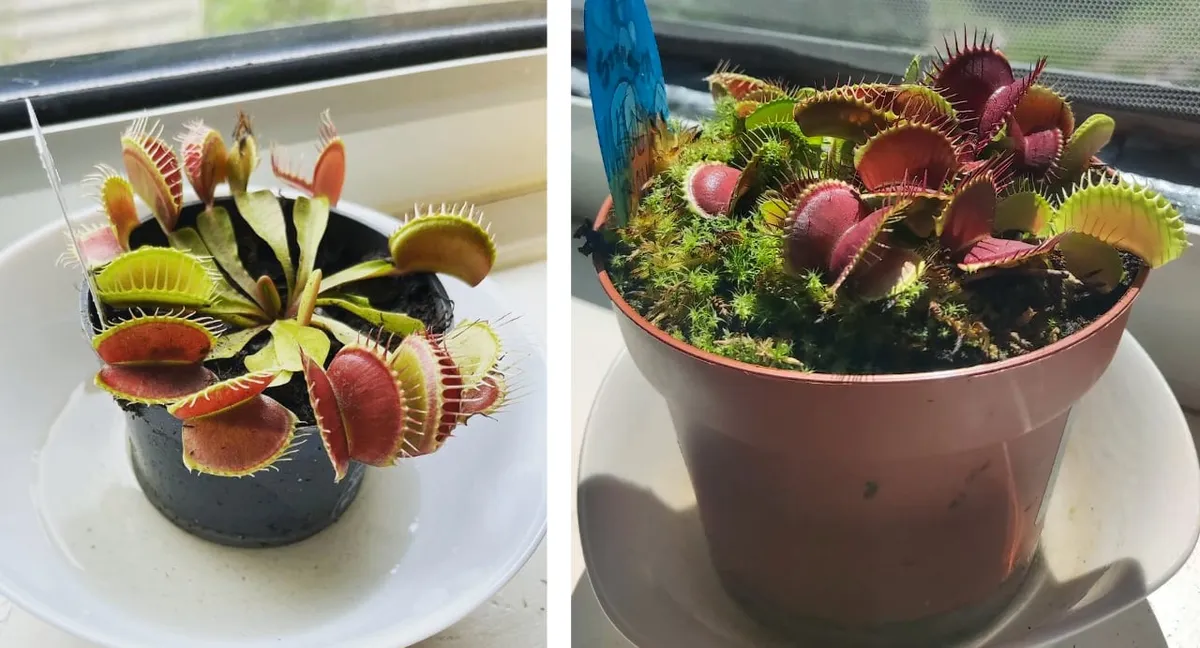
They do not require a terrarium to grow, although they can appreciate the higher humidity of the enclosed environment. They can be happy in terrariums provided you respect their winter dormancy requirements and provide sufficient light. Artificial lighting can work well, particularly high-powered fluorescents such as T5 growlights.
Venus flytraps grow extremely well in conservatories and unheated greenhouses. Temperatures in the Carolinas frequently hit 30°C (86°F) during summer and drop below 0°C in in the winter (32°F), and so Venus Flytraps are perfectly happy in the many temperate climates - including the UK and much of the US - provided they are protected from the elements.
Note that most Venus Flytraps produce different kinds of leaves throughout the growing season. Those produced at the start and end of the growing season (spring and autumn) tend to be lower-growing with heart-shaped petioles, while those produced in summer are held up higher on narrow, elongated petioles.
3. Soil & Water for Venus Flytrap
The traditional compost mixture for Venus Flytraps is sphagnum peat moss mixed with either lime-free horticultural sand or perlite, to a ratio of about 2:1. Hampshire Carnivorous Plants sell an excellent ready-made Venus flytrap soil. In the US, California Carnivores offers an excellent ready-made soil mix. Alternatively, you can buy this compost mix on Amazon worldwide.
An alternative peat-free growing media is pure long fibre sphagnum moss. I’ve had good success growing my own flytraps in pure sphagnum, and while it can be more expensive than a peat-based mix, it’s one of several peat-free solutions you might try. In the UK, I recommend The Sphagnum Shop - don’t forget to use the code TOMS10% to get 10% off your order.
During the growing season, you should stand the pot in about 1 cm of water (about ⅓ inch) and avoid watering from the top. They prefer to grow in soil which is wet, but not completely waterlogged. During winter they require less water, and the soil should be kept just damp.
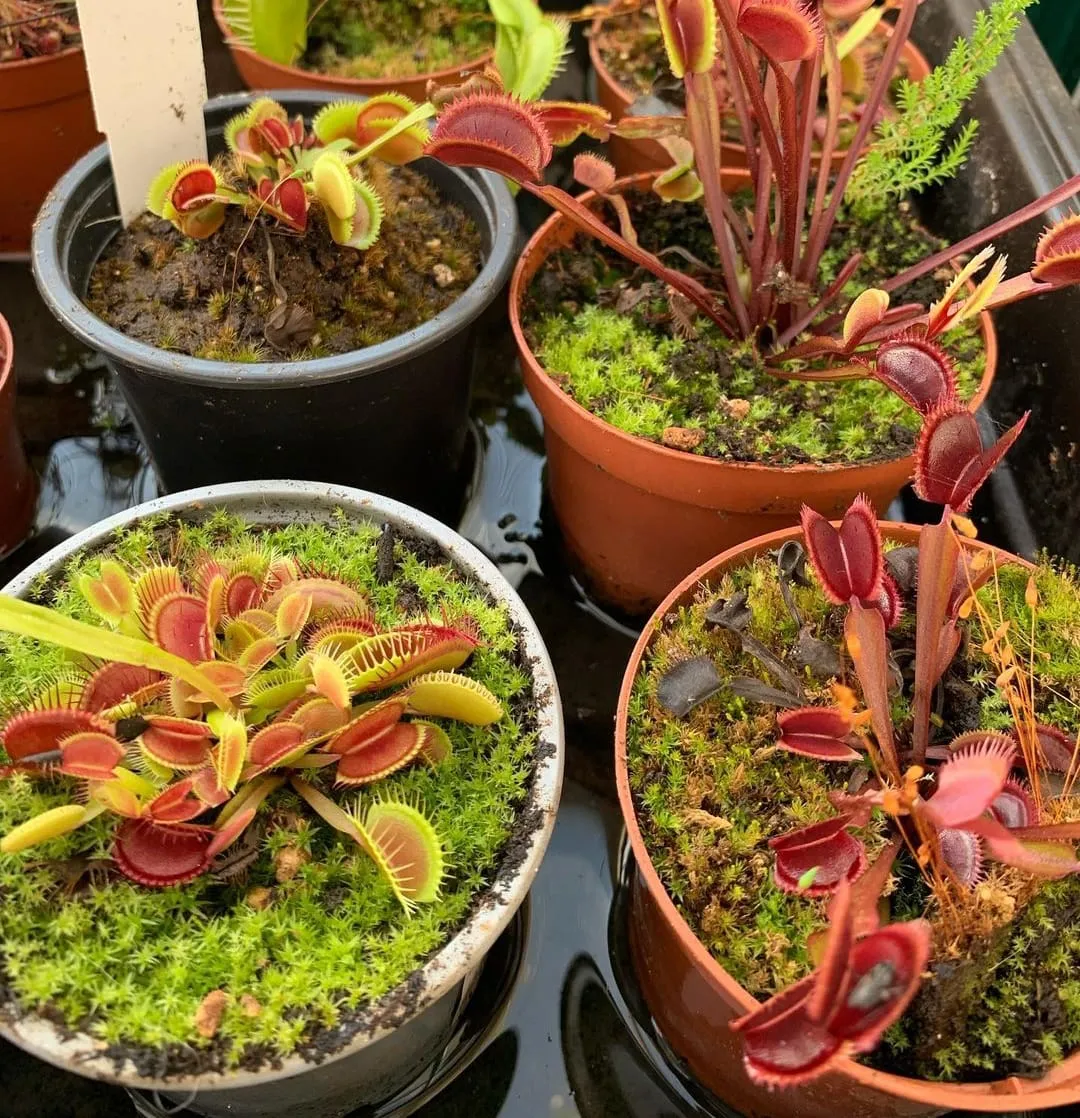
Another critical point which is often overlooked: Venus Flytraps need pure water. Like many other carnivorous plants, they evolved to grow in damp, low-nutrient soil, and giving them bottled, filtered, or tap water can result in a build-up of minerals that will eventually kill your Venus Flytrap. You should avoid fertilisers for similar reasons. Your best options are rainwater, distilled or deionised water, or water produced by a reverse osmosis system.
4. Winter Dormancy
Venus Flytraps require a cold winter dormancy between November and February. You need to mimic the conditions of their natural habitat, which means providing a cold resting period. Much like you need to sleep every night, Venus Flytraps need to go dormant over winter!
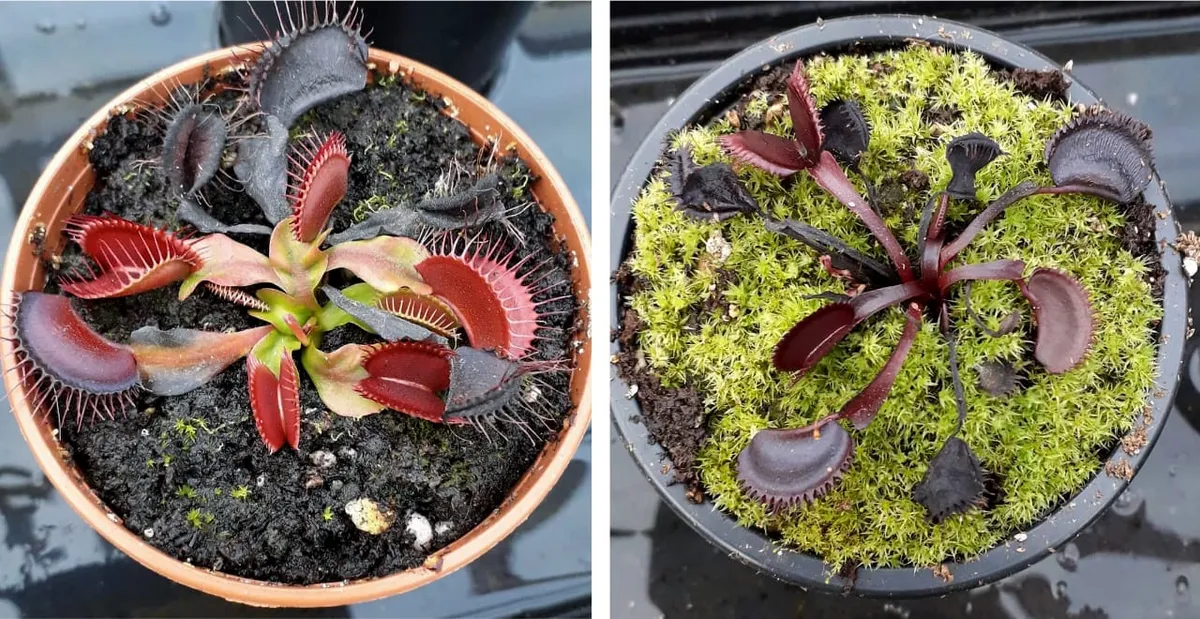
If you grow your plants on a windowsill or in a terrarium during the growing season, you will need to move them somewhere colder - sit them next to a window in your garage or shed, for example. Plants growing in unheated greenhouses can remain there over winter.
As the days shorten and the temperature drops, your plant’s leaves will start to turn black and your plant will die back to the rhizome. This is normal, and you can safely trim off any dead growth. The end of the winter dormancy period is a good opportunity to repot - and even divide - your plants if they require it before growth begins in March. A 10 cm (4 inch) pot is sufficient for adult plants.
5. Venus Flytrap Flowers & Seeds
Fully grown Venus Flytraps flower in Spring, but unless you intend to harvest seed, you should cut off the flower stalk once it’s reached about 5 cm tall. Flowering can be exhausting for Venus Flytraps, and most plants will grow more vigorously during summer if prevented from flowering.
I’ve written a detailed guide to Venus flytrap flowers which includes instructions for how to propagate cut flower stems into new plants!
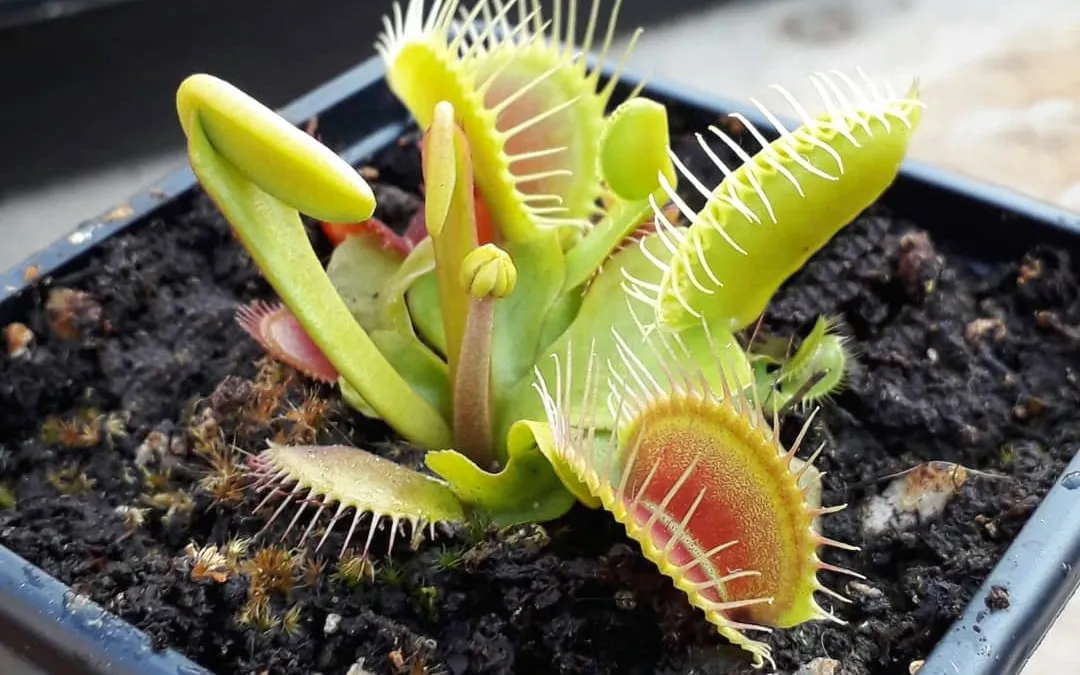
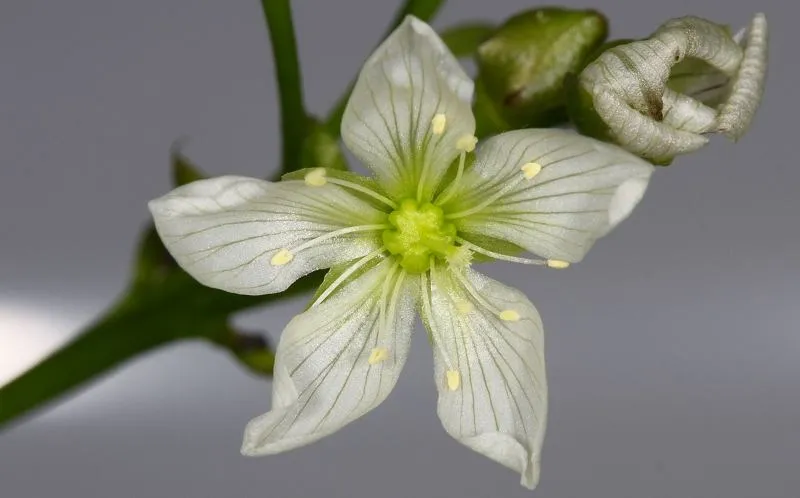
What about seeds?
Growing Venus flytraps from seed takes a lot of patience! It takes many years for seedlings to reach adult size, and for inexperienced growers it can sometimes be challenging to keep them alive. What’s more, eBay and Facebook are awash with fake seeds and scams! If you’d like to give it a try, always buy seed from a reputable specialist nursery.
In the UK, Hampshire Carnivorous Plants offers Venus Flytrap seed kits, as well as seed variety packs containing a mixture of less-challenging species.
California Carnivores sells a wide variety of Venus Flytrap seed packs, and these are available with free shipping throughout the US. You can also get a 10% discount off your order by using the code tomscarnivores.
If you wish to sexually propagate your own Venus Flytrap by collecting and sowing seeds, I recommend reading this article by Flytrapcare.com.
6. Feeding your Venus Flytrap
If grown outside, Venus Flytraps will catch more than enough food for themselves. If you keep your plants indoors then you can feed them with live or dead insects, but you should do so only once you’ve taken care of all their other growing requirements.
In order for Venus Flytraps to properly digest prey, the trigger hairs need to be stimulated after the trap has closed - this is to prevent the plant from wasting energy trying to digest non-edible matter which may have fallen into the trap. After dropping a dead insect into a trap, you can stimulate the trigger hairs with a toothpick, or by gently massaging the sides of the trap with your fingers.
If it’s time to feed your plant, check out my guide to feeding Venus Flytraps, in which I recommend a variety of suitable and easily-available foods.
7. Venus Flytrap Cultivars & Mutations
The single species of Venus Flytrap - Dionaea muscipula - has been bred horticulturally for many years. Growers have created hundreds of varieties, known as cultivars, and many of these are now available for sale.
All Venus Flytraps consist of a small rosette of leaves (called petioles), each of which ends in a trap. The traps of adult plants are typically around 2.5 cm in length, but can reach up to 5cm in some of the giant flytrap varieties.
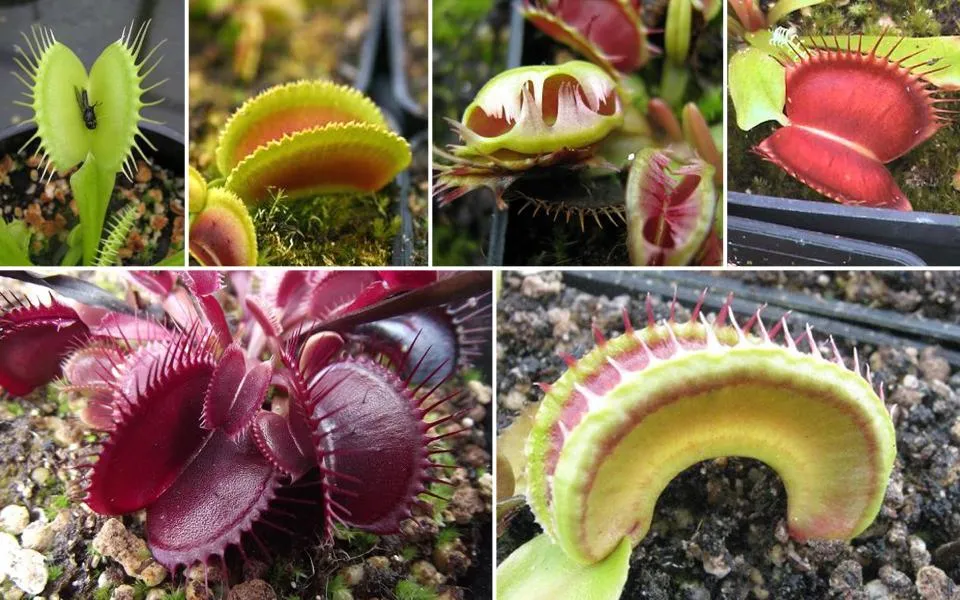
Cultivars are generally selected for colour, size, or mutation. The first group, particularly the all-green and all-red forms, are among the most popular. These include Dionaea ‘Justina Davis’, which remains completely green even in full sun, and Dionaea ‘Akai Ryu’ (also known as ‘Red Dragon’), which develops a striking maroon or burgundy colouration over the entire plant. Particularly large varieties include ‘Slack’s Giant’ and ‘South West Giant’, the latter of which originated in the UK.
Finally, there are the mutants. These are typically the result of tissue culture mishaps, and some are deformed to the point of being unable to catch prey. They are seemingly loved and hated in equal measure; while some growers enjoy the novelty, others find them grotesque!
8. Where can I buy a Venus flytrap?
In the UK, you can buy healthy Venus flytraps from Hampshire Carnivorous Plants, the biggest and longest-running carnivorous plant nursery in the country. Run by Matthew Soper, this nursery also sells compost, seeds, and carnivorous plant collections including ideal companions like Pitcher plants and Sundews. Quick delivery is available throughout the UK.
If you’re in the US, I wholeheartedly recommend California Carnivores. They have a wide range of Venus Flytraps available for delivery throughout the United States, as well as ideal companions like Pitcher plants and Sundews. You can also get 10% off your order with the code tomscarnivores.
Plants bought from specialist carnivorous plant nurseries will typically be much stronger and more robust than those from hardware / DIY stores. You’ll also get much better advice on successful growing, and you’ll be supporting a small business!
Still want to learn more?
Buy The Savage Garden, by Peter D’Amato. In my opinion, this is the single best book on carnivorous plants you can buy today. Its chapters on Dionaea are brilliantly detailed and great for beginners. Available on Amazon.
